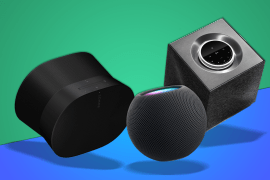Apple MacBook Pro review (M4, 2024): incredible power now infused with AI
Apple’s MacBook Pro has now been upgraded with the latest M4 chips in the form of the M4, M4 Pro and M4 Max
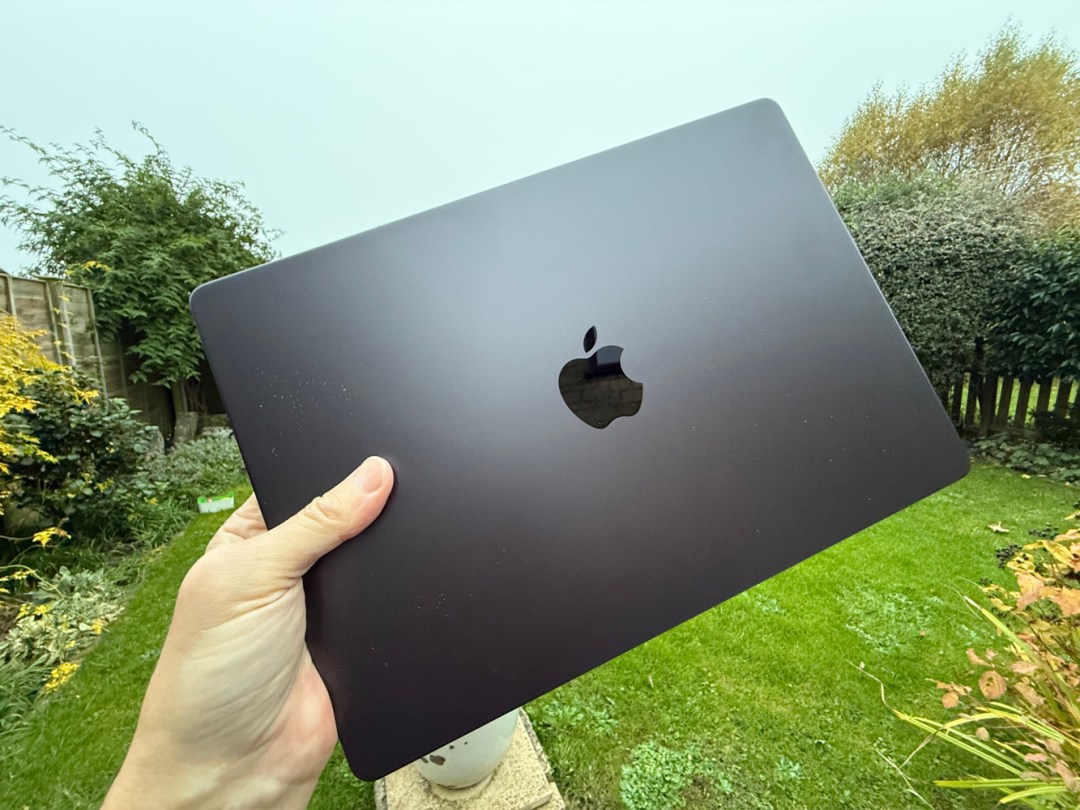
Stuff Verdict
If it’s performance you’re after, look no further – a simply incredible experience, now with a step-forward software experience with Apple Intelligence. Upgrades may come at a hefty price, but these l
Pros
- Outstanding performance=
- Superb display
- Great connectivity
- Incredible battery life that will last more than a day
Cons
- More power than many will need
- Upgrades are extremely pricey
- Apple Intelligence a work in progress
Apple’s MacBook Pro has always been one of the best laptops available and it’s now been upgraded with the latest M4 chips in the form of the M4, M4 Pro and M4 Max – the fourth generation of Apple’s ARM-based chips to make it into the Pro since the introduction of the M1 in late 2020.
As well as coming to the redesigned Mac mini, the M4 chip is also now in the iMac, too. But while the Mac mini is a very interesting little PC, it’s the introduction of the M4 series to the MacBook Pro that really shows the level of power these chips are capable of.
I’ve been sent two review models from Apple for this review. The first model is an off-the-shelf base level 14in M4 with 16GB of RAM and a 512GB SSD for $1,599/£1599. The second is a 16in M4 Max model but upgraded to have a huge 48GB of RAM and 2TB SSD for $3649/£3649. Upgrading the memory is an expensive affair because it’s unified memory. Likewise pumping the internal storage upwards is pretty extortionate; consider if you can cater for this need with external drives.
How we test laptops
Every laptop reviewed on Stuff is tested using industry standard benchmarks and apps to assess performance and battery life. We use our years of experience to judge display, sound and general usability. Manufacturers have no visibility on reviews before they appear online, and we never accept payment to feature products.
Find out more about how we test and rate products.
Design: more of the same


As in 2022 and 2023, the MacBook Pro unibody design remains unchanged from the 2021 rework that added back ports that had previously been taken off, like the SD card reader and HDMI port. It was also goodbye to the Touch Bar, lamented only by a few. You now get physical function keys instead. The keyboard too, was a reinvention of what had gone past, moving on ) from the disastrous butterfly keyboard era that cost Apple a lot of money in terms of repairs. Rubber feet sit the Mac nicely above any uneven surfaces that could scratch or split coffee on café tables. There’s no MacBook Pro wordmark under the display, but there is one moulded into the base. Once again the Pros come in a brace of ‘colour’ options – silver and space grey.
There are some rumours that Apple will revisit the MacBook Pro design in 2025. That would make sense to us, but while the current design may seem a little outdated compared to some, the fact remains that it still looks broadly appealing, is fairly robust and works well. Plus 2020s Apple isn’t exactly renowned for tearing up designs and starting again like Apple of the naughties.
Externally, the difference between the 14 and 16in versions are minimal aside from the physically larger device, larger display and bigger grilles either side of the keyboard.
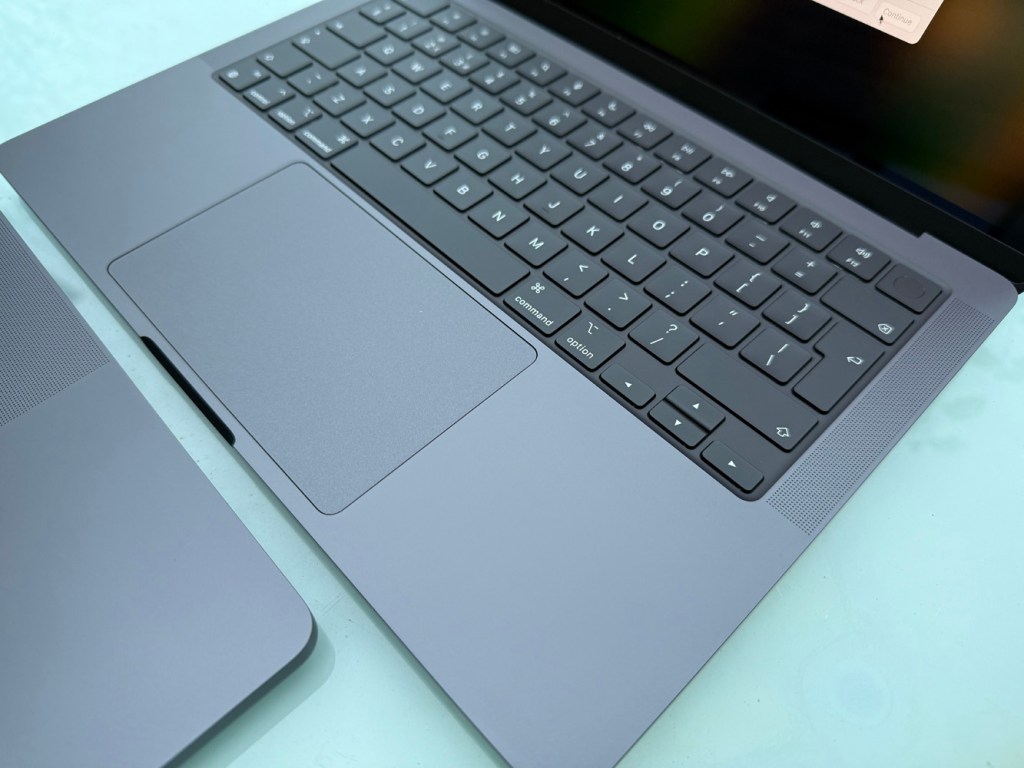
You once again get three USB-C ports (USB 4 and Thunderbolt 4) which you can charge from both ways. MagSafe is on the left side for the default charging solution. There’s also HDMI, an SDXC card reader and – yes! – a headphone jack. Just like the last three years, we’re surprised that HDMI is still here when many displays can be driven via USB-C. We like it, but we were surprised that Apple reintroduced it. Likewise the SD card reader which is surely highly underused.
Display and speakers: top-quality experience
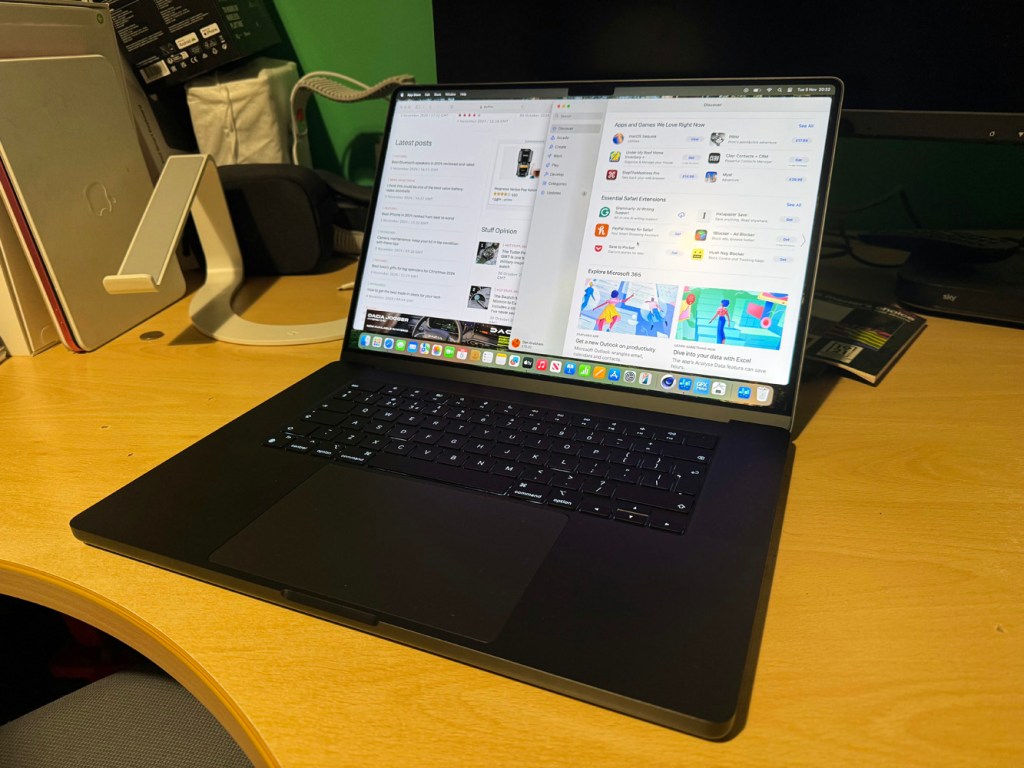
The mini LED displays on both models is simply stunning as previously uses Apple’s ProMotion variable refresh tech. The colours are terrific. The display is capable of 1600nits of brightness which is fine in all but the brightest conditions where I find there is still a little bit of a struggle to see the screen. There’s quite a difference in pixel count between the two sizes, too. To be expected perhaps, but it’s welcome to see a hefty jump. (3024 by 1964 pixels for the 14in and 3456 by 2234 for the 16in.
New this time is the option of a $150 nano-textured matt finish to the display. I’ve got it on my 16in review model. If you work in an environment where there is often glare – such as from strip lights or other bright sources – it may be welcome to you. As you can see below, it still reflects some light of course.

But honestly I don’t find the usual glossy display to have too much glare and as such we’re not convinced it’s a necessary upgrade. As I say though, there will be some environments where it is more welcome.
There’s a camera notch at the top of the display but once again this is not being used for Face ID. I absolutely cannot fathom why this hasn’t come to the Mac yet (Microsoft’s Windows Hello tech has been around for quite some time now). Maybe it wouldn’t play nicely with third-party apps? Maybe it needs to wait for Intel Macs to be unsupported – surely in the next couple of years? Who knows. The notch is only really a problem for long app menus or the Menu Bar where you inevitably have too many icons. We use a third-party app (iBar) to prioritise these.
Once again the webcam is much improved from Macs of old and is 1080p. Strangely though, the Mac still doesn’t support Centre Stage to keep you in the frame (it does work with Apple’s Studio Display).
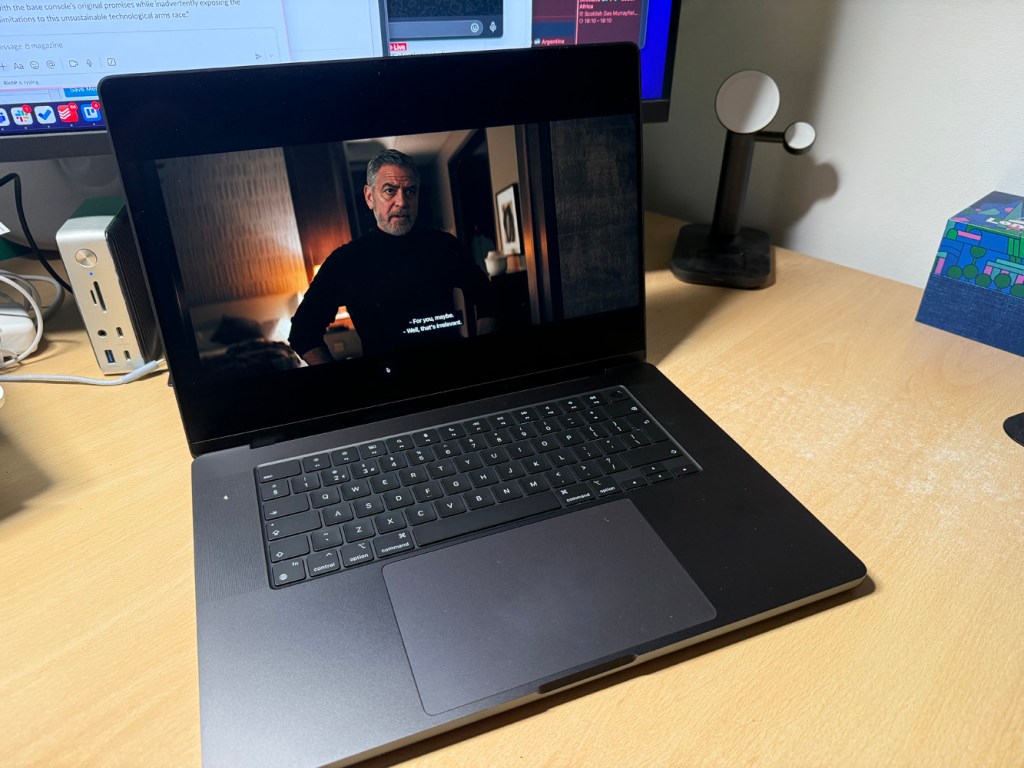
Audio is provided by a six-speaker array. It’s fine for video calls, watching video and music while you’re travelling – perhaps in a hotel room – but you’re not going to be sat at your desk using it as a replacement for a quality speaker system.
Performance and battery life: unbelievable power
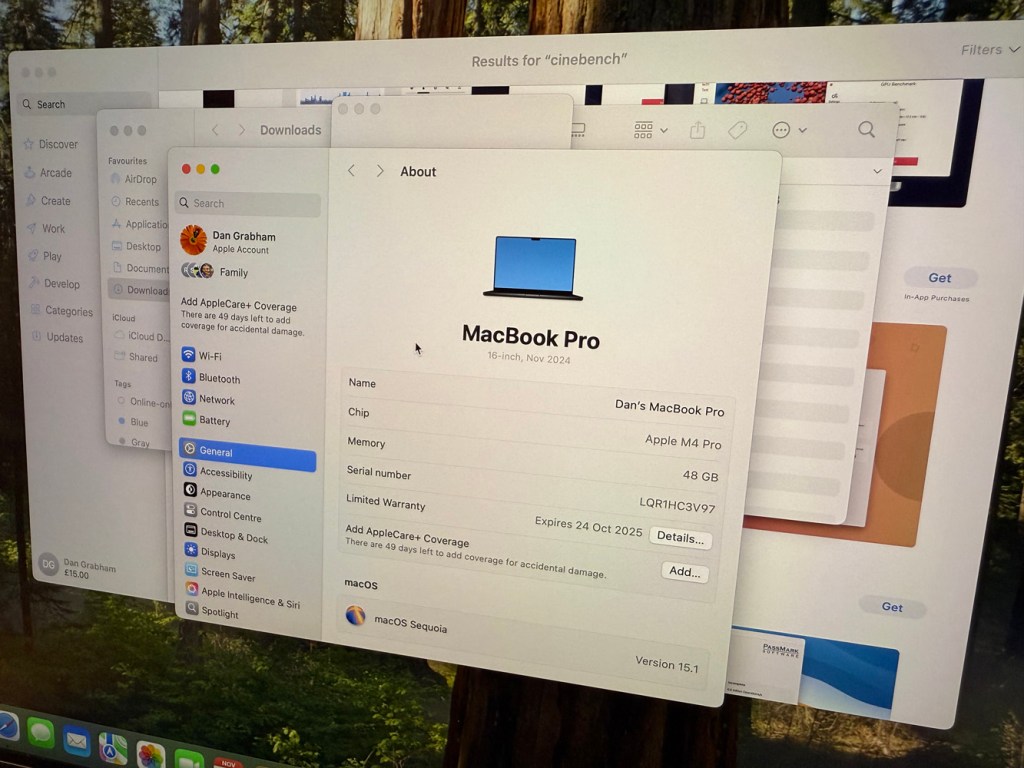
While the MacBook Air is passively cooled, the Pro still has fans though you’ll have to work hard to get them to spin up; they’re reserved for just the most intensive tasks. So for us they only kicked in for benchmarking for example. There are long vents on the side as well as under the display. You’ll find the Mac does get warm, but never hot.
I also have a 16in MacBook Pro which is my company machine that runs the top-notch (for the time) Intel Core i9. Looking at this Mac, it’s easy to see why Apple made the switch to Apple Silicon. It’s noisy, the battery life has always been fairly poor and the performance wasn’t the greatest even a couple of years ago.
Once again, the M4 and M4 Pro push the boundaries of what is possible with PC processing. We can’t judge the M4 Max as it’s not in front of us, but it should be even more formidable. Put simply, software can’t really challenge these chips at present. Software can always be better, of course, but these chips can handle everything you ask them to do.
Benchmarking the M4 Pro yields crazy results. Just as with previous versions, single core performance in Cinebench is world-beating, while multi-core performance only lags behind a couple of server chips. Server chips! A mad level of performance. I can’t wait to find out what the M4 Max can do, too. The SSD performance is also crazy – Blackmagic’s Disk Speed Test recorded write speeds of over 6500 MB per second. The M4 Pro boasts a 14‑core CPU and 20‑core GPU. The graphics capability on offer here is incredible. Video encoding is ripped through in seconds.
Battery life is claimed as a slight improvement on last year’s model at 24 hours (!) for video streaming on both of these models. The 14in has a 72.5Wh battery while the 16in has 100Wh, but Apple only claims a slight improvement for general tasks, what Apple calls ‘wireless web’ – 16 hours for the 14in and 17 hours for the M4 Pro 16in. You won’t get that, but you will get more out of it than you ever dreamed possible a few years ago. And certainly you can eke it out towards two days of work.
Once the dust settles and you’ve had this thing a while it’s still going to be able to get you through a full day of work and probably beyond provided you don’t tax it too much. And even if you do, you’ll find you aren’t going to be spending loads of time messing about with a charger. The key thing is that you’re not going to need to charge it over the course of a working day unless you’re really taxing it.
Software: introducing Apple Intelligence

macOS Sequoia (macOS 15, if you’re counting) is similar to the last few versions in that it is increasingly inspired by iOS and iPadOS in terms of some of the design, but it’s a hugely capable OS that feels so much better to work in than iPadOS with its limited multitasking capabilities. I have multiple desktops and apps on the go and even the standard M4 doesn’t flinch. And that applies if you have virtual machines running, working in Adobe Photoshop or editing a 4K movie. Easy. Thankfully there are now no app issues with Apple Silicon. This took a little while to iron out, but developers got there fairly rapidly. Certainly it’s no longer an issue.
There are numerous tweaks that come with a new version of macOS with the long-awaited window tiling maybe the best of them, but the key thing this time is in version 15.1 – the introduction of Apple Intelligence. It’s still US English only for now, but wider rollouts are imminent in 15.2 for Australia, Canada, Ireland, New Zealand, South Africa and the UK. Apple Intelligence is rather limited in appeal right now, despite what Apple says. But you’re able to toggle it off if you don’t want it.
You can type to Siri (or talk to it as before) and get suggestions. Siri has a draggable interface across your desktop and a more natural voice. Siri has improved a little, especially for context but don’t expect miracles as it’s still very much a work in progress.
You can also now get notification summaries just as on iOS. Messages are also summarised in Messages and Mail by default. This works sporadically well, just as on iOS. Sometimes Apple Intelligence hits the spot and sometimes it just doesn’t. Again you can fine-tune this per app – for example we have opted out of using it for text messages and WhatsApps so we can see the whole message as a notification each time.
Smart Reply in Mail is pretty good as are the Writing/Rewriting Tools, again a work in progress. But what’s there is a great start and the proofreading feature will impress current Grammarly users.
What is a revelation though is drag and drop for iPhone Mirroring – moving files and photos between both is so powerful and means you don’t need to AirDrop to send something to yourself.
15.2 will also bring Image Playground, enabling you to generate images using AI including Genmoji. You’ll also be able to use the ChatGPT integration. We haven’t tested 15.2 out for the purposes of this review as it is still a developer beta at the time of writing.
MacBoook Pro M4 verdict
Apple’s M4 MacBook Pro series is a special set of laptops. Apple isn’t just iterating on performance, it is seriously pushing the envelope year-on-year. Can it keep up with this cadence? Time will tell, but it feels like in a decade’s time, the M14 won’t offer the same performance gains. As I’ve said before, the main thing you need to comsider when buying a MacBook Pro is whether you actually need this level of power. While the MacBook Air M2 isn’t favoured by some regular Pro users, it is more than good enough to do what most traditional MacBook Pro users need. Essentially, the Pro is a high-end machine for high-end tasks. If you don’t regularly need the performance, then it’s hard to recommend the step-up in price from the Air. But if you are regularly undertaking some of those Pro-level tasks that are bread and butter foir the Pro, then go for it – you won’t be disappointed by the incredible levels of performance on offer here.
Stuff Says…
If it’s performance you’re after, look no further – a simply incredible experience, now with a step-forward software experience with Apple Intelligence. Upgrades may come at a hefty price, but these laptops will last you for years. You just need to consider if a MacBook Air is actually powerful enough for your needs.
Pros
Outstanding performance=
Superb display
Great connectivity
Incredible battery life that will last more than a day
Cons
More power than many will need
Upgrades are extremely pricey
Apple Intelligence a work in progress
MacBook Pro M4 technical specifications
| Screen | 4.2in or 16.2-inch Liquid Retina XDR 3024 by 1964 or 3456×2234 with P3, True Tone and ProMotion |
| Processor | Apple M4, M4 Pro or M4 Max |
| RAM | 16GB/32GB configurable to 128GB if you have M4 Max |
| Storage | 512GB/1TB SSD configurable up to 8TB |
| OS | macOS Sequoia (macOS 15) |
| Connectivity | 802.11ax Wi‑Fi 6E; Bluetooth 5.3; 3.5mm headphone; 3x Thunderbolt 4; MagSafe 3; HDMI; SDXC |
| Dimensions | 35.6 x 24.8 x 1.7cm |
| Weight | 1.55/2.15kg |




